Art Criticism
The 34th São Paulo Biennial Has Spread Out, Slowed Down, and Opened Itself Up—But Some Old Barriers Remain
“Though It’s Dark, Still I Sing” has been rethought to respond to the pandemic and the political moment.
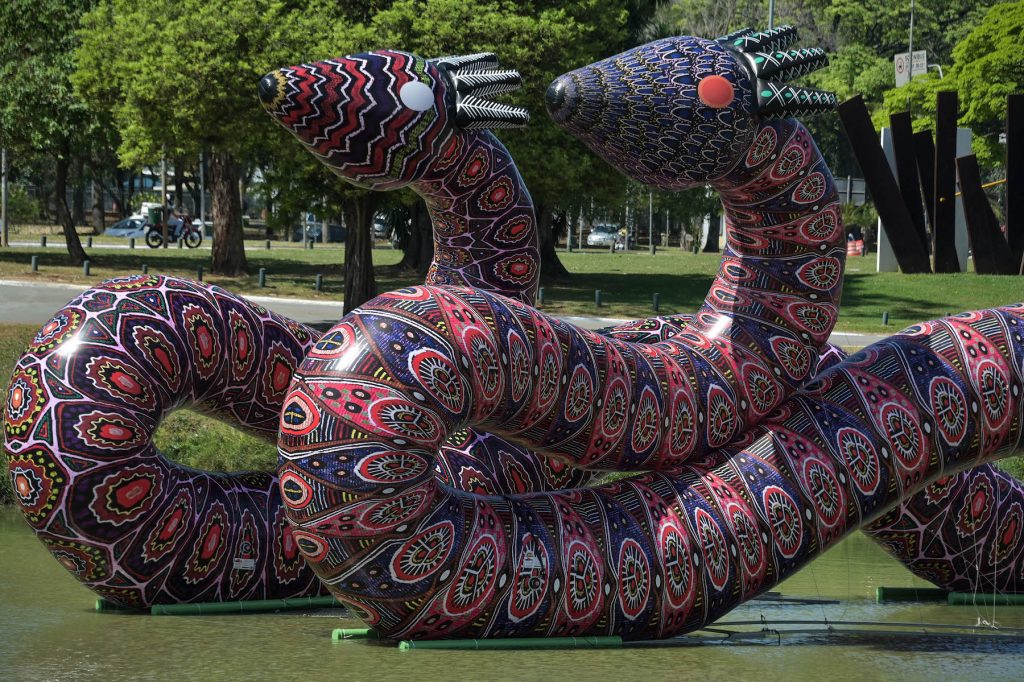
“Though It’s Dark, Still I Sing” has been rethought to respond to the pandemic and the political moment.

Tiago Gualberto

“An ex-tree” or “what was once a tree.” This is the meaning of Ibirapuera, a word of indigenous Tupi origin. It is also the name of the park where São Paulo’s Biennial Foundation is located, the most traditional center for the visual arts in Brazil. The Tupiniquim, Caeté, Tupinambá, and Potiguara are just some of the countless indigenous groups that spoke Tupi before the language was absorbed by Jesuits and Portuguese colonizers in the 16th century. The city of São Paulo may be the greatest Brazilian example of this obscure appropriation and the 34th São Paulo Biennial may be one of its most symbolic events.
“Though It’s Dark, Still I Sing” (Faz escuro mas eu canto) is a verse from a poem by Thiago de Mello from 1963. It is also the title of the new edition of the Biennial, which was inaugurated in February 2020. Yet the traditional opening to the public of the Modernist pavilion designed by Oscar Niemeyer and Hélio Uchôa, which is three floors tall with more than 34,000 square meters (approximately 365,973 square feet), was postponed for more than a year and a half, to September 4, 2021.
Beyond the well-known global impact of the COVID-19 pandemic and its restrictions, the disastrous and genocidal—as many would call it—inaction of the Brazilian federal government in the distribution of vaccines continues to demand serious precautions and have dire consequences. Brazil is dealing with much more than just a lag in São Paulo’s cultural calendar, enduring an imminent threat to the already precarious social and political conditions in the country, both as a result of the circulation of new variants of the virus and as a result of constant attacks on democracy.
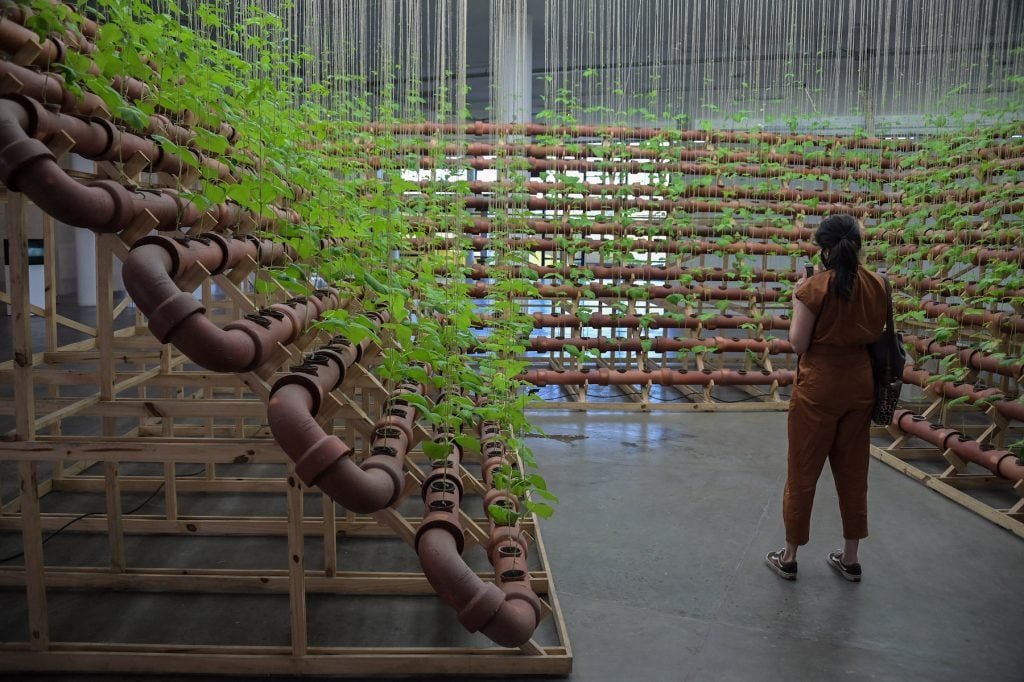
A work of Peruvian artist Ximena Garrido-Lecca during the press day ahead of the opening of the 34th Biennale of Sao Paulo, at Ibirapuera park, in Sao Paulo, Brazil. (Photo by Nelson Almeida/AFP via Getty Images)
On top of these broader obstacles, the arts in Brazil are facing an environment of precarious and insufficient public funding for artists and other producers of culture. All of this is illustrated by the dissolution of the Ministry of Culture and the tumultuous appointments of five different secretaries of culture in just three years of the presidency of Jair Bolsonaro. The massive fire at São Paulo’s Cinematheque on July 30 of this year, which destroyed a large part of a precious collection that included films by Glauber Rocha (1939-1981) and so many other important filmmakers, illuminates the conditions that so many Brazilian public institutions face in the present.
Keeping this background in mind helps to explain some of the sense of purpose behind this new edition of São Paulo’s Biennial. In part, there is the goal to reactivate cultural and artistic institutions in the city in a massive and expansive way. This began with its curatorial project to partner with a network of more than twenty institutions, most of them traditional and private, on expanded (though asynchronous) programming for the Biennial.
Beyond the massive central exhibition at the Ciccillo Matarazzo Pavilion composed of nearly 1,100 works by 90 artists from 39 different countries, there are other individual and collective exhibits by established artists such as Antônio Dias (1944-2018) and Giorgio Morandi (1890-1964), as well as artists lesser-known by international critics, such as Juraci Dórea (b. 1944).
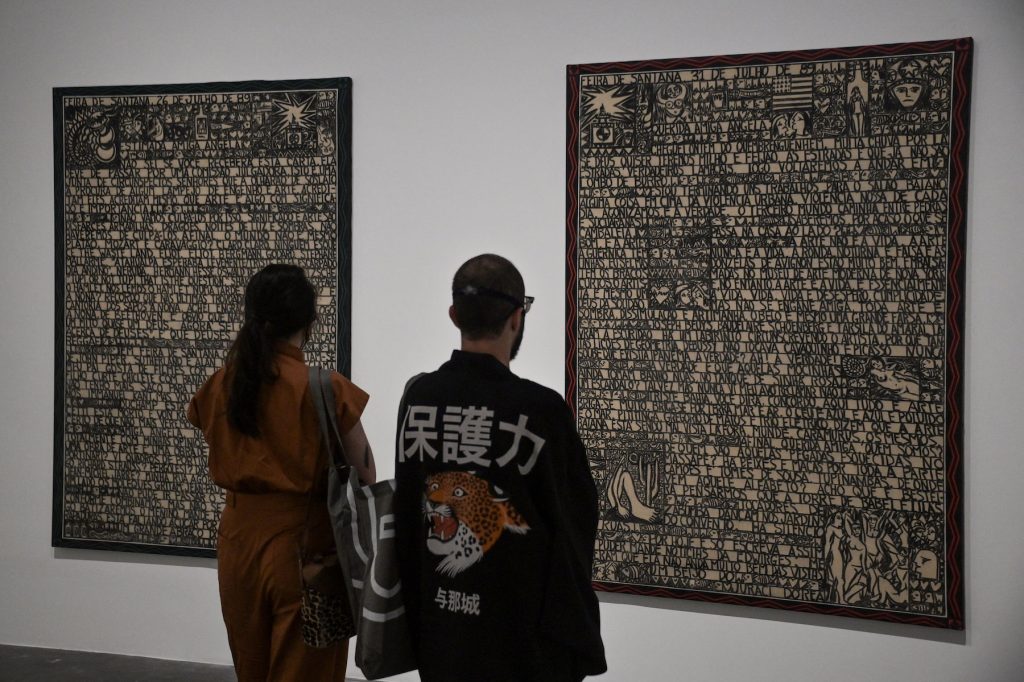
A work of Brazilian artist Juraci Dorea during the press day ahead of the opening of the 34th Biennale of Sao Paulo, at Ibirapuera park, in Sao Paulo, Brazil. (Photo by Nelson Almeida/AFP via Getty Images)
These shows are hosted in institutions such as the Contemporary Art Institute (IAC), the Bank of Brazil Cultural Center (CCBB), and the Brazilian Museum of Sculpture and Ecology (MuBe). Among the stand-out exhibitions are those dedicated to sharing the vital contributions of the educator Paulo Freire (1921-1997), “Occupation Paulo Freire” (Ocupação Paulo Freire), at the institution Itaú Cultural, and of the writer Carolina Maria de Jesus (1914-1977), “Carolina Maria de Jesus: A Brazil for All Brazilians” (Carolina Maria de Jesus: um Brasil para todos os brasileiros), at the Instituto Moreira Salles Paulista.
As the curators Jacopo Crivelli Visconti, Paulo Myada, Carla Zaccagnini, Francesco Stocchi, and Ruth Estévez emphasize, “the point of departure was the desire to expand the show in both time and space.” The delays, in this sense, were strategically transformed into opportunities to exercise curatorial discretion, seeking the opportunity to deepen the dialogue between works, artists, and curators, recasting them as “rehearsals.”
The introductory show, “Wind” (Vento), initially held almost a year ago in the same pavilion where the principal exhibition now is, was one such moment. It had a deliberately limited group works of 21 artists, conceived of as a kind of musical score activating the architecture, and creating a space to explore points of contact among all involved—including, in particular, the public.
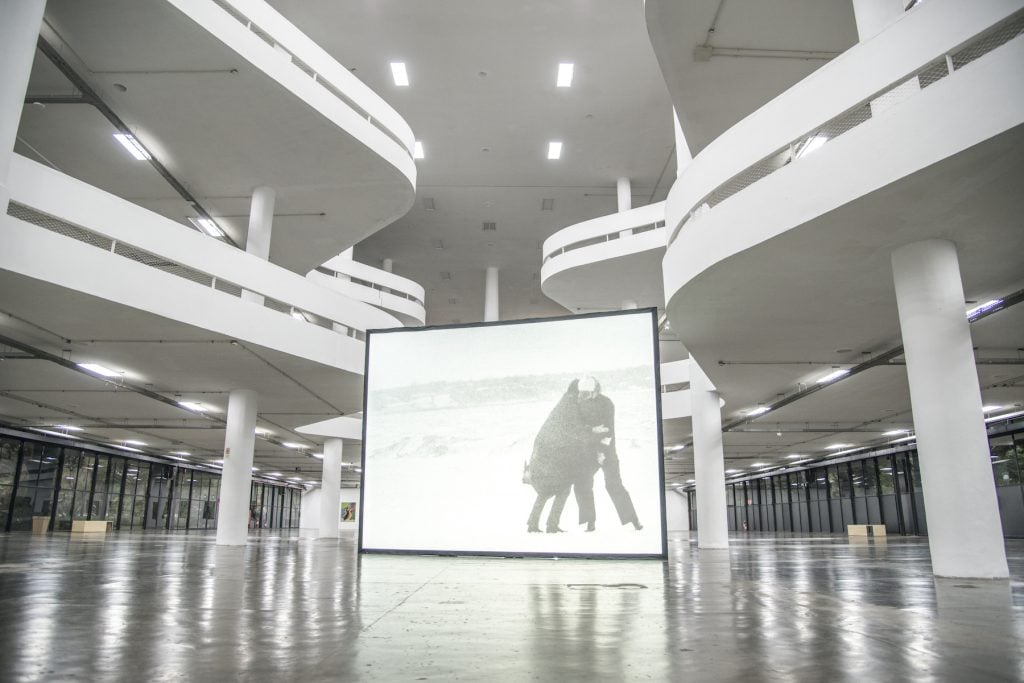
Installation view of Wind (1968) by Joan Jonas in Vento. Photo by Levi Fanan. Courtasy Fundação Bienal de São Paulo.
Unlike the sparse and linear occupation of the pavilion in “Wind” (Vento), the now-open main exhibition dresses up of part of the Modernist skeleton with what has been called “skin”: jute textiles, and polycarbonate and plywood sheets. Though seemingly modest, this intervention in the architecture of the building intensifies the drama for the spectator moving through the space—activating the architecture in a very different way than the deliberately restrained and empty “Wind,” providing a kind of rhyme for those who experienced both.
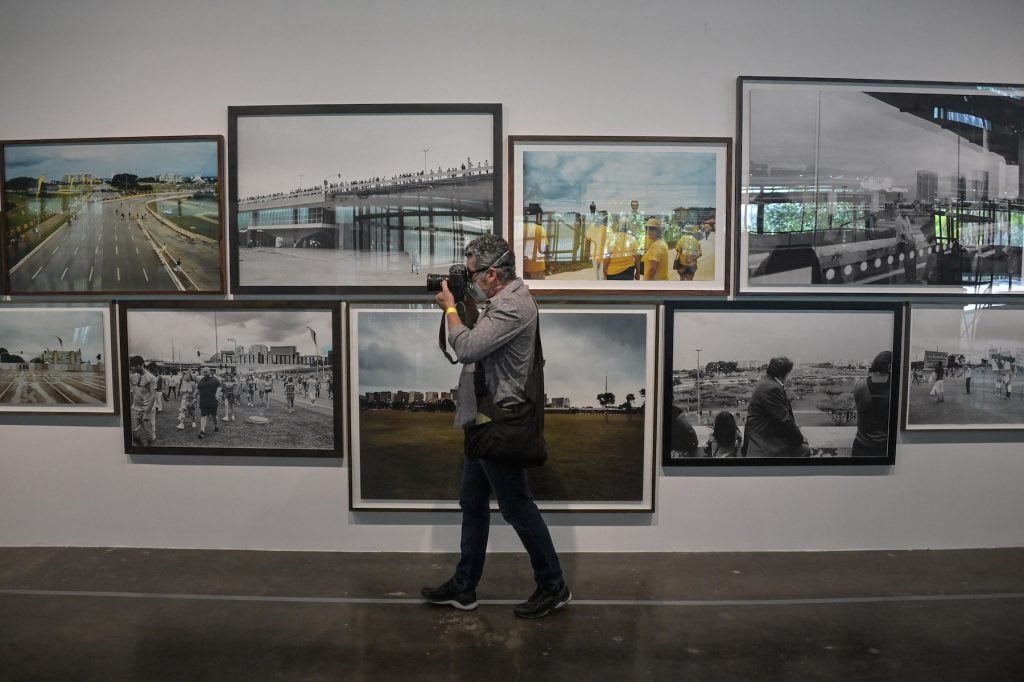
Works by Brazilian photographer Mauro Restiffe at the 34th Biennale of Sao Paulo, at Ibirapuera park, in Sao Paulo, Brazil. (Photo by Nelson Almeida/AFP via Getty Images)
The building’s famous, steep access ramps to the different floors of the pavilion take viewers into a show that embraces many different agendas, among them the celebration of Black and indigenous artists representation in the Biennial. A variety of artworks with a distinctly political character, already well known by the Brazilian public, are highlighted. Among them are great works by Lygia Pape (b. 1927-2004) and Mauro Restiffe (b. 1970).
Other impressive artistic interventions include Brazilian artist Arjan Martins’s installation, composed of a gigantic iron anchor leaned along the building in a position of dialogue with the unprecedented presentation of tens of photographic portraits of the U.S. abolitionist Frederick Douglass.
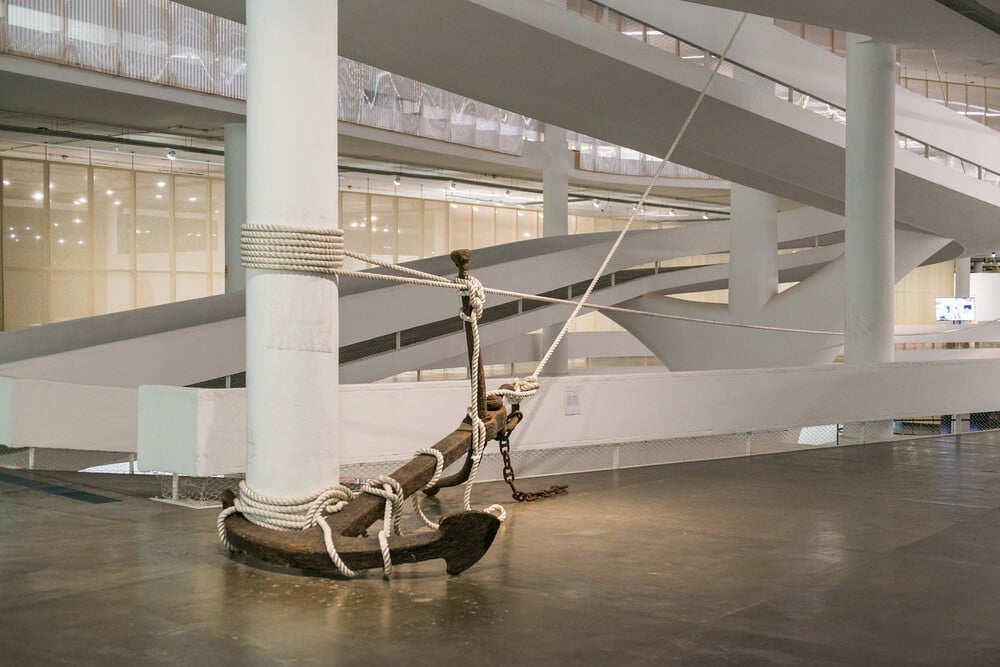
Arjan Martins, Atlantic Complex (Rope) (2021). Image courtesy of the artist and the Bienal de São Paulo.
The condition of “rehearsals,” of prolonging and suspending the time of the biennial, also opened the possibility for some artists to explore how current events were reshaping the image of the past.
The toppling of monuments in the United States and Europe has generated echoes in Brazil. Among these, the recent burning of a grand sculpture built by Júlio Guerra between 1957 and 1963, titled Borba Gato, stands out. (The leader of the movement Peripheral Revolution (Revolução Periférica), Paulo “Galo” Lima, claimed responsibility for the act.) Borba Gato, the subject of the now-toppled sculpture, is known as “an enslaver, a kidnapper, who killed indigenous peoples and brought more enslavement to the province of São Paulo,” as one expert put it, but is still quite celebrated in the city of São Paulo.
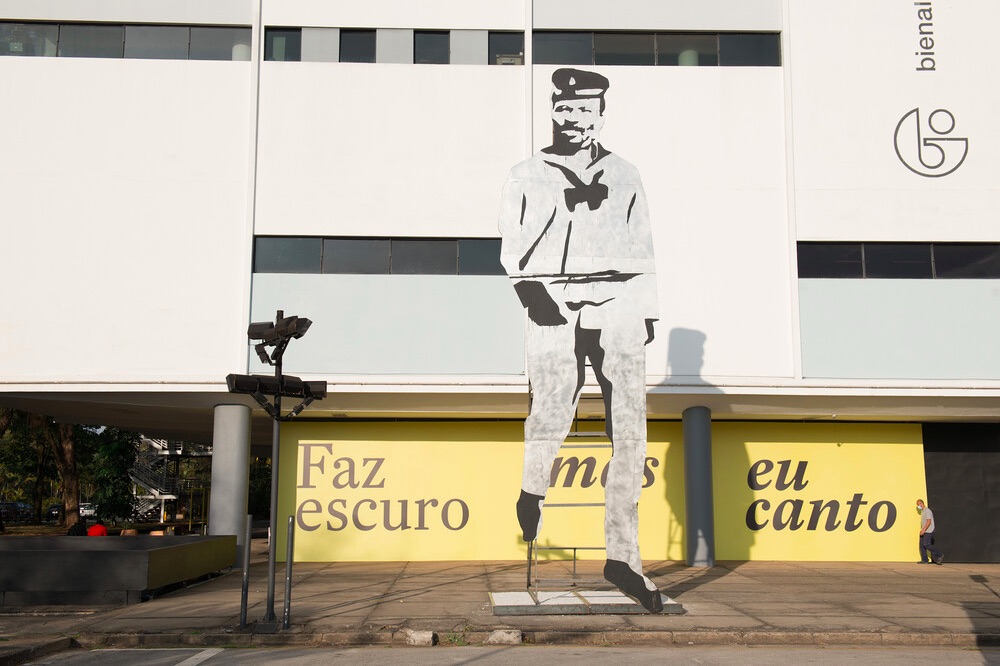
Paulo Nazareth, Corte seco (Dry Cut) (2021). © Levi Fanan / Fundação Bienal de São Paulo. Image courtesy of the artist and the Bienal de São Paulo.
In an apparent response to this unfolding debate about monuments, the artists Paulo Nazareth (b. 1977) and Jaider Esbell (b. 1979) share their own temporary monuments in the park surrounding the Biennial. Among his works, Nazareth presents monumental figures of a cast of Black personalities built using sheets of metal similar to the ones used for outdoor billboards in Brazil.
Meanwhile, Esbell, the artist who gave the name “Biennial of the Indian” to this year’s Biennial, presents two huge inflatable serpents that symbolize the indigenous Makuxi people.
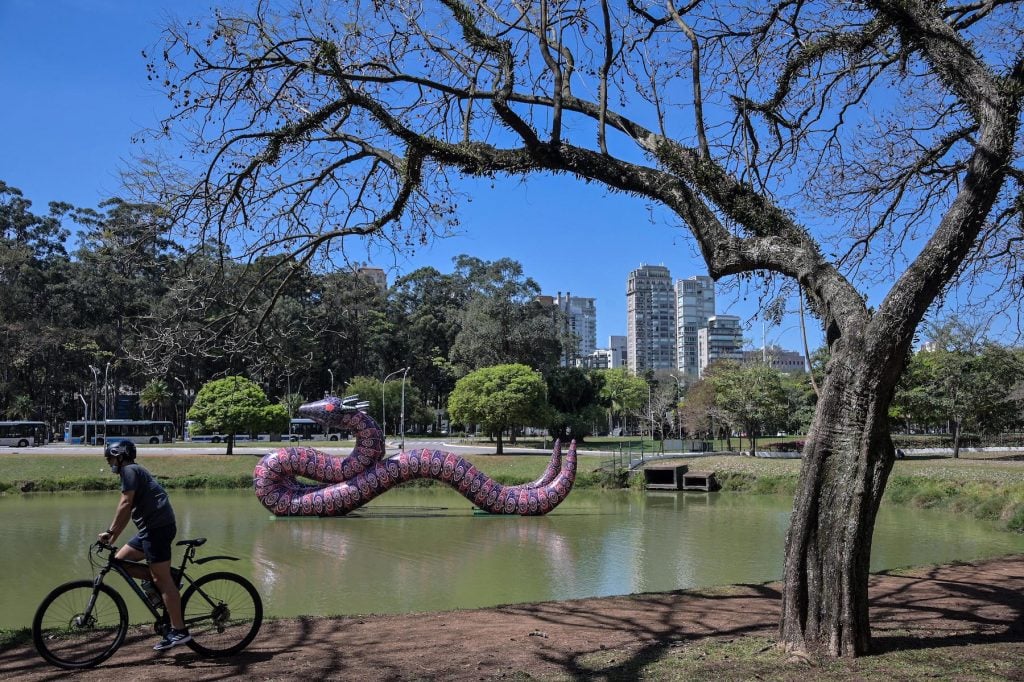
A picture taken on September 2, 2021 shows a work of Brazilian artist Jaider Esbell during the press day ahead of the opening of the 34th Biennale of Sao Paulo, at Ibirapuera park, in Sao Paulo, Brazil. (Photo by Nelson Almeida/AFP via Getty Images)
Both interventions call on us to recover and celebrate Black and indigenous ancestral histories, at a time when monuments to colonizers are coming down. It is a mixed gesture. On the one hand, the monumental nature of these works contrasts with a Biennial composed mostly of subtle and opaque arrangements; on the other, the impermanent character of these monumental productions also dims their chances of overcoming the typical ephemerality of publicity campaigns.
One of the devices presented in this year’s Biennial is the use of that which the curators called “enunciations” (enunciados). Much the way an epigraph marks the opening of a text, the “enunciations” are objects and artifacts, selected for their remarkable story, around which the rest of the artistic works are presented.
Among them are letters written from prison between 1972-1974 by the historian Joel Rufino dos Santos (1941-2015) to his son Nelson. Beyond teaching us lessons about the history of Brazil through showing deep affection to his infant child, the letters bear witness to the state violence after the 1964 coup and to Santos’s capacity to circumvent the review of the letters carried out by the military dictatorship’s censors.
Another “enunciation” is a series of objects that survived the fire that consumed the headquarters of Brazil’s National Museum in September 2018 in Rio de Janeiro. This tragedy destroyed almost the entire collection of the institution of 20 million historic and scientific items. The meteorite of Santa Luzia, discovered in 1921 in the State of Goiás, is one of these remaining fragments.
Such curatorial interventions offer fundamental references for our political, social, and affective education within the art in this exhibition. They also transcend the local Brazilian context: Yet another of these interventions is the group of images of the 19th century U.S. abolitionist Frederick Douglass I have already mentioned.
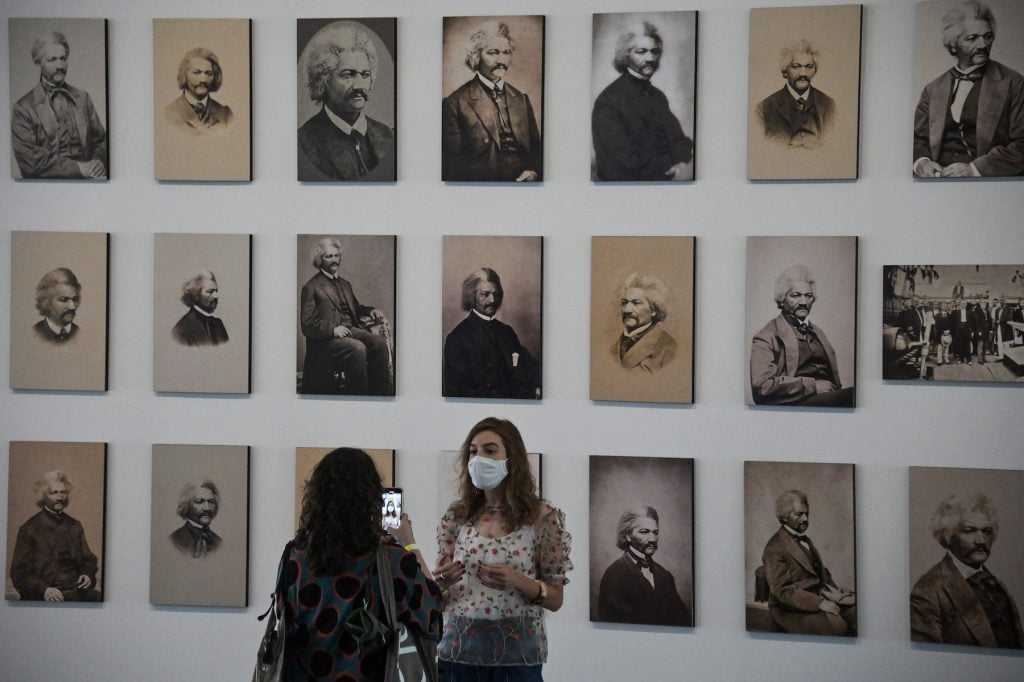
Pictures of Frederick Douglas on view at the 34th Biennale of Sao Paulo, at Ibirapuera park, in Sao Paulo, Brazil. (Photo by Nelson Almeida/AFP via Getty Images)
Douglas, a figure little-known to the Brazilian public, defended the humanity of the enslaved and attacked the exclusion of the history of Africa in the narratives of the development of civilization. The struggle between master and slave is a constant theme in his texts, especially in his autobiographies.
The hundreds of photographs illuminating Douglass’s face that are available in the space of the Biennial are much more than mere propaganda. Douglass, as the historian Paul Gilroy teaches us in The Black Atlantic (1993), was known to use “carefully deployed ambiguity” in his writing. Writing of one incident in his emancipation, where Douglas says that the “gleam or shadow” of another escaped slave may have influenced him—two concepts with seemingly opposed meanings—Gilroy argues that the phrase may be “a cryptic acknowledgement of the different ways in which black and white readers were likely to respond to the tale.”
I mention this because it is precisely Douglass’s sense of confidence in his audience’s abilities to dwell in ambiguity that seems to be missing from a good part of the artistic works at the 34th São Paulo Biennial.
As I sought to highlight in this text, a pool of forces is present in the Brazilian scene, which is heir to a past marked by colonial violence and racism. And the city of São Paulo concentrates the greatest number of representatives of the beneficiaries of this past. The climate crisis and the COVID-19 pandemic only reinforce the urgency of a public debate regarding the role of each one of us in reorganizing our lives, including artists. And if, on the one hand, the 34th São Paulo Biennial stands out for not ignoring the commitment to articulating struggles from the past, on the other, it seems more committed to looking at the past than offering transformative propositions for the future.
Ancestry, colonial violence, and racism become inescapable subjects in this biennial—but especially for its indigenous and Black artists, whose work is presented more as testimony than as part of a conversation about aesthetics. Some artists appear to be content with celebrating the visibility of becoming representatives of a racialized cultural category. The youngest are the most vulnerable to this “forced opportunity.” Perhaps for this reason, it is easier to identify this delicate condition in the works presented at this Biennial by artists Daira Tukano (b. 1982) and Uyra (b. 1991) for example.
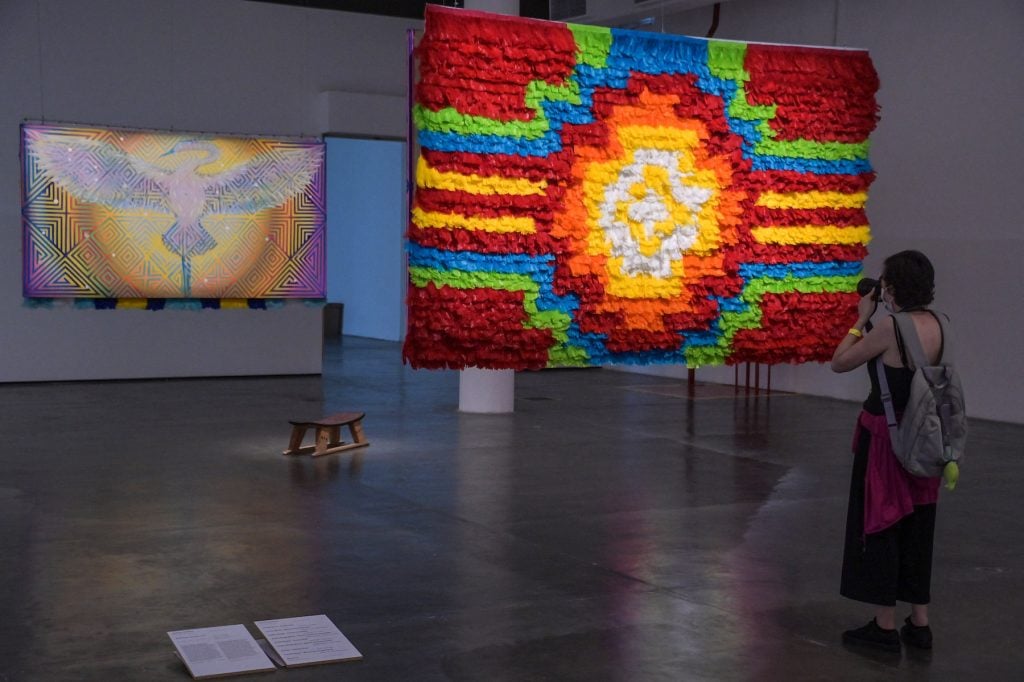
Works by Brazilian artist Daiara Tukano during the press day ahead of the opening of the 34th Biennale of Sao Paulo, at Ibirapuera park, in Sao Paulo, Brazil. (Photo by Nelson Almeida/AFP via Getty Images)
The freedom of not having to adhere to racial and ethnic categories of belonging, in the case of this Biennial, seems to only be guaranteed to a select group of artists. They are free to conduct their aesthetic and political projects, to reach for thematic transcendence, to be inscribed in art history books. And they are—and this is not by chance—white artists.
Consider these works: a large installation of corridors with glass walls full of holes and graphic hints at shrapnel, Landscape (Paisagem) by Regina da Silveira (b. 1939); the monotypes in silk and paper titled Mouth of Hell (Boca do Inferno) (2020), by Carmela Gross (b. 1946), where one can observe the repetition of dark masses and forms; or Education by Night (Educação pela noite) (2020), by Clara Ianni (b. 1987), where the projection of shadows plays tricks on our perception and hints at attention to the official discourses.
Though tangentially connected to specificities of the Brazilian political and historical landscape, these productions are not viewed together as a series of examples of the production of women artists, even if they all are. Neither do they come to represent the collective index of their ethnic backgrounds.
There is thus a mismatch between the works of the white artists in the show and the Black and indigenous artists, who, while willing participants, were not afforded the time and space—that is to say, freedom—to think outside of rigid racial categories. These institutional expectations around identity and representation, commonly-held in Brazil’s art circuit, precede this particular Biennial and extend far beyond its walls.
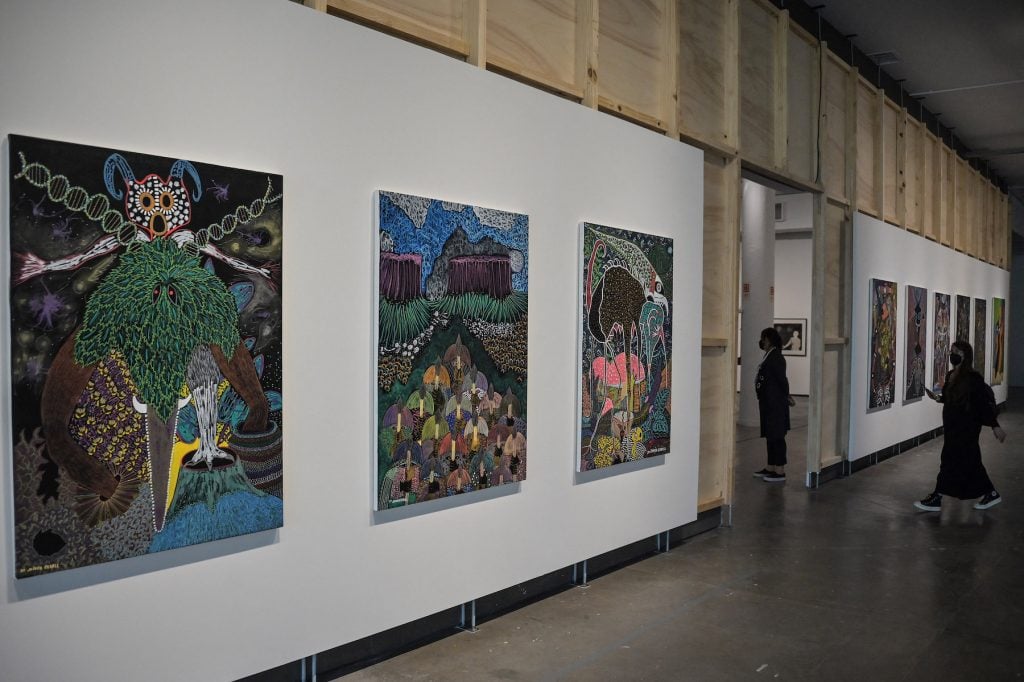
Paintings by Jaider Esbell during the 34th Biennale of Sao Paulo, at Ibirapuera park, in Sao Paulo, Brazil. (Photo by Nelson Almeida/AFP via Getty Images)
What such distinctions marked by the idea of race conceal, whether on the part of the artists themselves or on the part of the curators of the Biennial, is a barrier to consolidating relationships of equality across difference. Non-white artists are forced into less nuanced categories; the value of opacity is not permitted. Meanwhile those who do not face racism as a constant threat, or as an inescapable theme, are permitted the luxuries of “rehearsal.”
The 34th Biennial of São Paulo is one of the most diverse instances of this important event in the city. This is worth celebrating—even as the questions of privilege and violence linger in ways still to be addressed.
The 34th Bienal de São Paulo, “Though It’s Dark, Still I Sing” is on view through December 5, 2021.
Translation: Ramón J. Stern